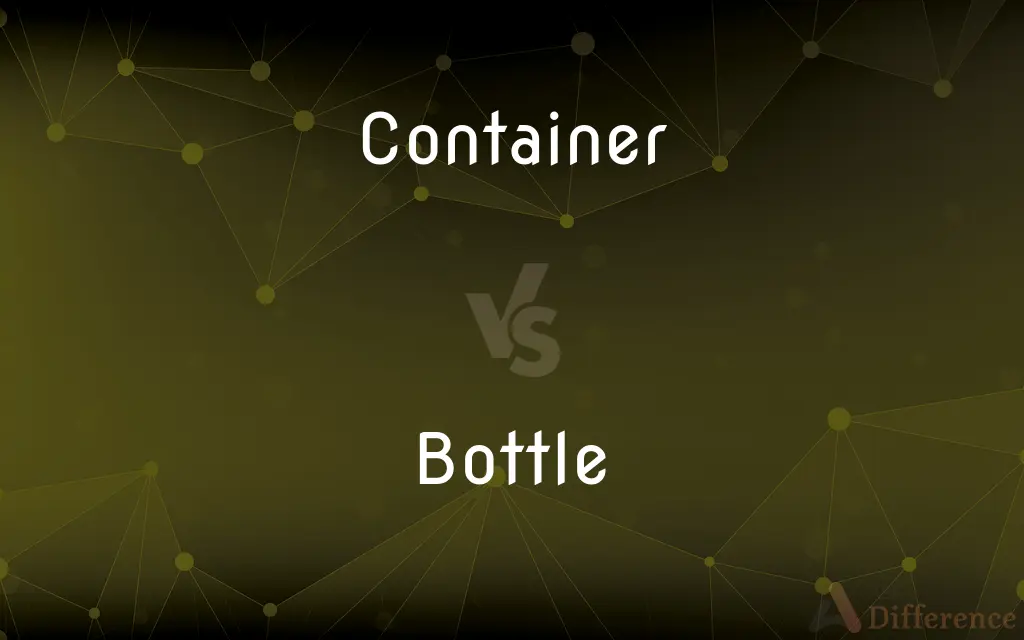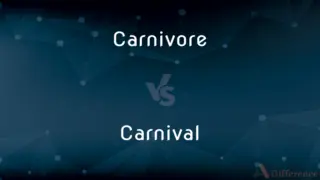Container vs. Bottle — What's the Difference?
By Fiza Rafique & Urooj Arif — Updated on March 19, 2024
A container is a generic term for any item that can hold substances, whereas a bottle is specifically designed to hold liquids and has a neck that constrains the flow.

Difference Between Container and Bottle
Table of Contents
ADVERTISEMENT
Key Differences
Containers encompass a broad range of items designed to hold, store, or transport substances, including solids, liquids, gases, or a combination of these. They can be made of various materials like plastic, metal, glass, or cardboard and come in many shapes and sizes depending on their intended use. Bottles, on the other hand, are a subtype of container specifically designed for holding liquids. They typically feature a narrow neck and mouth, which makes pouring and controlling the flow of liquid easier, and can be sealed with a cap, cork, or lid.
While containers can serve a multitude of purposes across different industries—from food storage to chemical handling bottles are often used for beverages, pharmaceuticals, and household liquids. The design of a bottle, including its shape, size, and the material it's made from, is tailored to suit the liquid it's meant to hold, preserve its contents, and facilitate its use.
Containers might be reusable or single-use, designed for long-term storage or for transporting goods over distances. Bottles also share these characteristics but are additionally designed with portability in mind, often fitting into specific spaces like car cup holders or refrigerator doors, and they frequently come with features that make them easier to carry, such as handles or grooves.
In terms of environmental impact, both containers and bottles, especially those made of plastic, are subjects of concern regarding waste and recycling. However, there has been a significant push towards designing both containers and bottles to be more sustainable, utilizing recyclable materials or creating designs that are easier to reuse or recycle.
Understanding the differences and uses of containers and bottles is crucial in industries like packaging, logistics, and product design, where the right choice of packaging can affect the product's quality, usability, and sustainability.
ADVERTISEMENT
Comparison Chart
Definition
A generic term for items designed to hold, store, or transport substances.
A specific type of container designed to hold liquids, with a narrow neck.
Types of Contents
Solids, liquids, gases.
Primarily liquids.
Material
Plastic, metal, glass, cardboard, etc.
Commonly plastic, glass, or metal.
Shape and Design
Varies widely depending on use.
Typically features a narrow neck and mouth.
Use
Broad across various industries.
Primarily for beverages, pharmaceuticals, household liquids.
Special Features
Depends on the specific type and use.
Designed for easy pouring and flow control; often portable.
Compare with Definitions
Container
Essential for organization and logistics.
Clear containers are great for organizing craft supplies.
Bottle
Features a narrow neck and mouth.
The olive oil bottle made it easy to drizzle without spilling.
Container
Designed for storage and transport.
Shipping containers are used to transport goods globally.
Bottle
Can be sealed for freshness.
The soda bottle's cap keeps the contents fizzy.
Container
Any item that can hold substances.
The chef stored the leftovers in a plastic container.
Bottle
Portable and convenient for individual use.
Portable bottles make staying hydrated on the go easier.
Container
Can be for single or multiple uses.
Reusable food containers help reduce waste.
Bottle
Commonly made from plastic or glass.
Glass bottles are preferred for preserving the taste of beer.
Container
A container is any receptacle or enclosure for holding a product used in storage, packaging, and transportation, including shipping. Things kept inside of a container are protected by being inside of its structure.
Bottle
Designed specifically for liquids.
She filled her water bottle before the hike.
Container
Varies in materials and sizes.
Metal containers are often used for storing paints.
Bottle
A bottle is a narrow-necked container made of an impermeable material (clay, glass, plastic, aluminium etc.) in various shapes and sizes to store and transport liquids (water, milk, beer, wine, ink, cooking oil, medicine, soft drinks, shampoo, and chemicals, etc.) and whose mouth at the bottling line can be sealed with an internal stopper, an external bottle cap, a closure, or a conductive "inner seal" using induction sealing. Some of the earliest bottles appeared in China, Phoenicia, Crete, and Rome.
Container
An object for holding or transporting something
The cakes will keep for up to two weeks if kept in an airtight container
Bottle
A receptacle having a narrow neck, usually no handles, and a mouth that can be plugged, corked, or capped.
Container
A receptacle, such as a carton, can, or jar, in which material is held or carried.
Bottle
The quantity that a bottle holds.
Container
A large reusable receptacle that can accommodate smaller cartons or cases in a single shipment, designed for efficient handling of cargo.
Bottle
A receptacle filled with milk or formula that is fed, as to babies, in place of breast milk.
Container
Someone who contains; something that contains.
Bottle
Intoxicating liquor
Don't take to the bottle.
Container
An item in which objects, materials or data can be stored or transported.
Bottle
The practice of drinking large quantities of intoxicating liquor
Her problem is the bottle.
Container
(transportation) A very large, typically metal, box used for transporting goods.
Bottle
To place in a bottle.
Container
(by extension) Someone who holds people in their seats or in a (reasonably) calm state.
Bottle
To hold in; restrain
Bottled up my emotions.
Container
(computing) A file format that can hold various types of data.
Bottle
A container, typically made of glass or plastic and having a tapered neck, used primarily for holding liquids.
Beer is often sold in bottles.
Container
(object-oriented programming) An abstract data type whose instances are collections of other objects.
Bottle
The contents of such a container.
I only drank a bottle of beer.
Container
Any user interface component that can hold further (child) components.
Bottle
A container with a rubber nipple used for giving liquids to infants, a baby bottle.
The baby wants a bottle.
Container
(computing) A bundle consisting of operating system, application code and dependencies to be run sandboxed inside a virtualized environment; (by extension) the environment itself.
Bottle
(originally "bottle and glass" as rhyming slang for "arse") Nerve, courage.
You don’t have the bottle to do that!
He was going to ask her out, but he lost his bottle when he saw her.
Container
One who, or that which, contains; particularly, an artifactual object that is designed to contain some fluid or solid material, object or objects, especially for convenience in transporting the contained objects.
Bottle
A container of hair dye, hence with one’s hair color produced by dyeing.
Did you know he’s a bottle brunette? His natural hair color is strawberry blonde.
Container
A large metallic box designed to hold many smaller boxes or packages, and used for convenience in loading and unloading large quantities of freight, such as on ships, trains, or airplanes.
Bottle
(obsolete) A bundle, especially of hay; something tied in a bundle.
Container
Any object that can be used to hold things (especially a large metal boxlike object of standardized dimensions that can be loaded from one form of transport to another)
Bottle
(figurative) Intoxicating liquor; alcohol.
To drown one’s troubles in the bottle
To hit the bottle
Bottle
A dwelling; habitation.
Bottle
A building; house.
Bottle
(transitive) To seal (a liquid) into a bottle for later consumption. Also fig.
This plant bottles vast quantities of spring water every day.
Bottle
To feed (an infant) baby formula.
Because of complications she can't breast feed her baby and so she bottles him.
Bottle
To refrain from doing (something) at the last moment because of a sudden loss of courage.
The rider bottled the big jump.
Bottle
To throw away a leading position.
Liverpool bottled the Premier League.
Bottle
To strike (someone) with a bottle.
He was bottled at a nightclub and had to have facial surgery.
Bottle
To pelt (a musical act on stage, etc.) with bottles as a sign of disapproval.
Meat Loaf was once bottled at Reading Festival.
Bottle
Of pages printed several on a sheet: to rotate slightly when the sheet is folded two or more times.
Bottle
A hollow vessel, usually of glass or earthenware (but formerly of leather), with a narrow neck or mouth, for holding liquids.
Bottle
The contents of a bottle; as much as a bottle contains; as, to drink a bottle of wine.
Bottle
Fig.: Intoxicating liquor; as, to drown one's reason in the bottle.
Bottle
A bundle, esp. of hay.
Bottle
To put into bottles; to inclose in, or as in, a bottle or bottles; to keep or restrain as in a bottle; as, to bottle wine or porter; to bottle up one's wrath.
Bottle
Glass or plastic vessel; cylindrical with a narrow neck; no handle
Bottle
The quantity contained in a bottle
Bottle
Store (liquids or gases) in bottles
Bottle
Put into bottles;
Bottle the mineral water
Common Curiosities
What makes a bottle different from other containers?
A bottle is specifically designed for liquids, featuring a narrow neck that aids in pouring and controlling the flow.
Are all bottles made of plastic or glass?
While plastic and glass are common, bottles can also be made of metal, ceramic, or other materials suited to their contents.
Can a container hold liquids just like a bottle?
Yes, containers can hold liquids, but bottles are tailored for liquid storage and use, offering more convenience and control.
Can both containers and bottles be recycled?
Yes, many containers and bottles are designed to be recyclable, but their recyclability depends on the materials they're made from and local recycling facilities.
How do I choose between a container and a bottle for packaging?
The choice depends on the product being packaged; liquids are generally best suited to bottles for ease of use, while solids can be stored in various types of containers.
Are containers and bottles subject to environmental regulations?
Yes, there are increasing regulations focused on reducing waste from containers and bottles, including requirements for recyclable materials and reduced plastic use.
Is there a trend towards more sustainable containers and bottles?
Yes, there is a growing trend towards sustainability in packaging, including the use of recycled materials and designs that are easier to reuse or recycle.
Why do bottles have narrow necks?
Narrow necks help control the flow of liquid, making it easier to pour without spilling and to measure out quantities.
How important is the material of a bottle or container in determining its use?
Material choice is crucial as it affects the container's or bottle's durability, suitability for the contents, and impact on taste or chemical stability.
What role do containers and bottles play in logistics and transportation?
They are essential for safely and efficiently transporting goods, protecting contents during shipping, and ensuring products arrive in good condition.
Share Your Discovery

Previous Comparison
Carnivore vs. Carnival
Next Comparison
Redo vs. RemakeAuthor Spotlight
Written by
Fiza RafiqueFiza Rafique is a skilled content writer at AskDifference.com, where she meticulously refines and enhances written pieces. Drawing from her vast editorial expertise, Fiza ensures clarity, accuracy, and precision in every article. Passionate about language, she continually seeks to elevate the quality of content for readers worldwide.
Co-written by
Urooj ArifUrooj is a skilled content writer at Ask Difference, known for her exceptional ability to simplify complex topics into engaging and informative content. With a passion for research and a flair for clear, concise writing, she consistently delivers articles that resonate with our diverse audience.















































